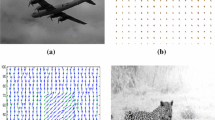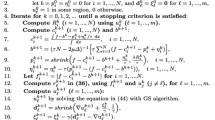Abstract
We present a geometric model and a computational method for segmentation of images with missing boundaries. In many situations, the human visual system fills in missing gaps in edges and boundaries, building and completing information that is not present. Boundary completion presents a considerable challenge in computer vision, since most algorithms attempt to exploit existing data. A large body of work concerns completion models, which postulate how to construct missing data; these models are often trained and specific to particular images. In this paper, we take the following, alternative perspective: we consider a given reference point within the image, and then develop an algorithm which tries to build missing information on the basis of the given point of view and the available information as boundary data to the algorithm. Starting from this point of view, a surface is constructed. It is then evolved with the mean curvature flow in the metric induced by the image until a piecewise constant solution is reached. We test the computational model on modal completion, amodal completion, and texture segmentation. We extend the geometric model and the algorithm to 3D in order to extract shapes from low signal/noise ratio ultrasound image volumes. Results in 3D echocardiography and 3D fetal echography are also presented.
Similar content being viewed by others
References
Caselles, V., Catte', F., Coll, T., and Dibos, F. 1993. A geometric model for active contours. Numerische Mathematik, 66:1–31.
Caselles, V., Kimmel, R., and Sapiro, G. 1997a. Geodesic active contours. IJCV, 22(1):61–79.
Caselles, V., Kimmel, R., Sapiro, G., and Sbert, C. 1997b. Minimal surfaces based object segmentation. IEEE Trans. PAMI, 19(4):394–398.
Chan, T.F. and Vese, L.A. 1998. Active contours without edges. CAM Report 98-53, UCLA Dept. of Mathematics.
DoCarmo, M.P. 1976. Differential Geometry of Curves and Surfaces. Prentice Hall: Englewood Cliffs, NJ.
Gabor, D. 1946. Theory of communication. J. Inst. Elect. Eng., 93:429–457.
Giaquinta, M. and Hildebrandt, S. 1996. Calculus of Variations I. Springer-Verlag: Berlin.
Gregory, R.L. 1972. Cognitive contours. Nature, 238(5358):51–52.
ter Haar Romeny, B.M. (Ed.). 1994. Geometry Driven Diffusion in Computer Vision. Kluwer: Dordrecht.
Julesz, B. 1981. Textons, the elements of texture perception, and their interactions. Nature, 91(7):91–97.
Kanizsa, G. 1976. Subjective contours. Scientific American,48–52.
Kanizsa, G. 1979. Organization in Vision. Hardcover.
Kanizsa, G. 1980. Grammatica del vedere Il. Mulino.
Kass, M., Witkin, A., and Terzopoulos, D. 1988. Snakes: Active contours models. IJCV, 1(4):321–331.
Kimmel, R., Malladi, R., and Sochen, N. 2000. Images as embedded maps and minimal surfaces: Movies, color, texture, and medical images. International Journal of Computer Vision, 39(2):111–129.
Lee, T.S. 1996. Image representation using 2D Gabor-wavelets. IEEE Transaction on Pattern Analysis and Machine Intelligence, 18(10):959–971.
LeVeque, R.J. 1992. Numerical Method for Conservation Laws. Birkhauser: Boston, MA.
Malik, J., Belongie, S., Leung, T., and Shi, J. 2000. Contour and texture analysis for image segmentation. In Perceptual Organization for Artificial Vision Systems, K.L. Boyer and S. Sarkar (Eds.). Kluwer Academic: Dordrecht.
Malik, J., Belongie, S., Shi, J., and Leung, T. 1999. Textons, contours and regions: Cue combination in image segmentation. Int. Conf. Computer Vision, Sept. 1999, Corfu, Greece.
Malladi, R. and Sethian, J.A. 1996. Image processing: Flows under min/max curvature and mean curvature. Graphical Models and Image Processing, 38(2):127–141.
Malladi, R. and Sethian, J.A. 1998. real-time algorithm for medical shape recovery. In Proceedings of ICCV'98, Mumbai, India, Jan. 1998, pp. 304–310.
Malladi, R., Sethian, J.A., and Vemuri, B. 1993. Topology independent shape modeling scheme. SPIE Proceedings on Geometric Methods in Computer Vision II, San Diego, pp. 246–258.
Malladi, R., Sethian, J.A., and Vemuri, B.C. 1995. Shape modeling with front propagation: A level set approach. IEEE Transactions on Pattern Analysis and Machine Intelligence, 17(2):158–175.
Marr, D. 1982. Vision. W.H. Freeman & Co.: San Francisco.
Mumford, D. 1994. Elastica and computer vision. In Algebraic Geometry and Its Applications, Chandrajit Bajaj (Ed.). Springer-Verlag: New York.
Mumford, D. and Shah, J. 1989. Optimal approximations by piecewise smooth functions and associated variational problems. Communications on Pure and Applied Mathematics, XLII:577–685.
Nishikawa, S. and Schoen, R. 1996. Geometric Variational Problems. Springer-Verlag: Tokyo.
Osher, S. and Sethian, J.A. 1988. Front propagating with curvature dependent speed: Algorithms based on Hamilton Jacobi formulation. Journal of Computational Physics, 79:12–49.
Perona, P. 1995. Deformable kernels for early vision. IEEE Transactions on Pattern Analysis and Machine Intelligence, 17(5):488–499.
Perona, P. and Malik, J. 1987. Scale space and edge detection using anisotropic diffusion. In Proc. IEEE Computer Society Workshop on Computer Vision.
Sarti, A. and Malladi, R. 2002. A geometric level set model for ultra-sound image analysis. LBNL-44442, Lawrence Berkeley National Laboratory, Oct. 1999; Geometric Methods in Bio-Medical Image Processing, R. Malladi (Ed.). Springer Verlag: New York.
Sarti, A., Malladi, R., and Sethian, J.A. 2000. Subjective surfaces: A method for completion of missing boundaries. In the Proceedings of the National Academy of Sciences, 97(12):6258–6263.
Sarti, A., Malladi, R., and Sethian, J.A. Elastic Subjective Surfaces, in preparation.
Sarti, A., Mikula, K., and Sgallari, F. 1999. Nonlinear multiscale analysis of 3D echocardiographic sequences. IEEE Transactions on Medical Imaging, 18(6):453–466.
Sarti, A., Ortiz, C., Lockett, S., and Malladi, R. 2000. A unified geometric model for 3D confocal image analysis in cytology. In IEEE Transactions on Biomedical Engineering, 47(12):1600–1609.
Saund, E. 1999. Perceptual organization of occluding contours generated by opaque surfaces. CVPR.
Sethian, J.A. 1985. Curvature and the evolution of fronts. Comm. Math. Phys., 101:487–499.
Sethian, J.A. 1987. Numerical methods for propagating fronts. In Variational Methods for Free Surface Interfaces, P. Concus and R. Finn (Eds.). Springer-Verlag: New York.
Sethian, J.A. 1999. Level Set Methods and Fast Marching Methods. Cambridge University Press: Cambridge.
Sochen, N., Kimmel, R., and Malladi, R. 1998. A general framework for lowlevel vision. IEEE Transactions on Image Processing, 7(3).
Williams, L.R. and Jacobs, D.W. 1997a. Stochastic completion fields: A neural model of illusory contour shape and salience. Neural Computation, 9(4):837–858.
Williams, L.R. and Jacobs, D.W. 1997b. Local parallel computation of stochastic completion fields. Neural Computation, 9(4):859–881.
Author information
Authors and Affiliations
Rights and permissions
About this article
Cite this article
Sarti, A., Malladi, R. & Sethian, J. Subjective Surfaces: A Geometric Model for Boundary Completion. International Journal of Computer Vision 46, 201–221 (2002). https://doi.org/10.1023/A:1014028906229
Issue Date:
DOI: https://doi.org/10.1023/A:1014028906229




